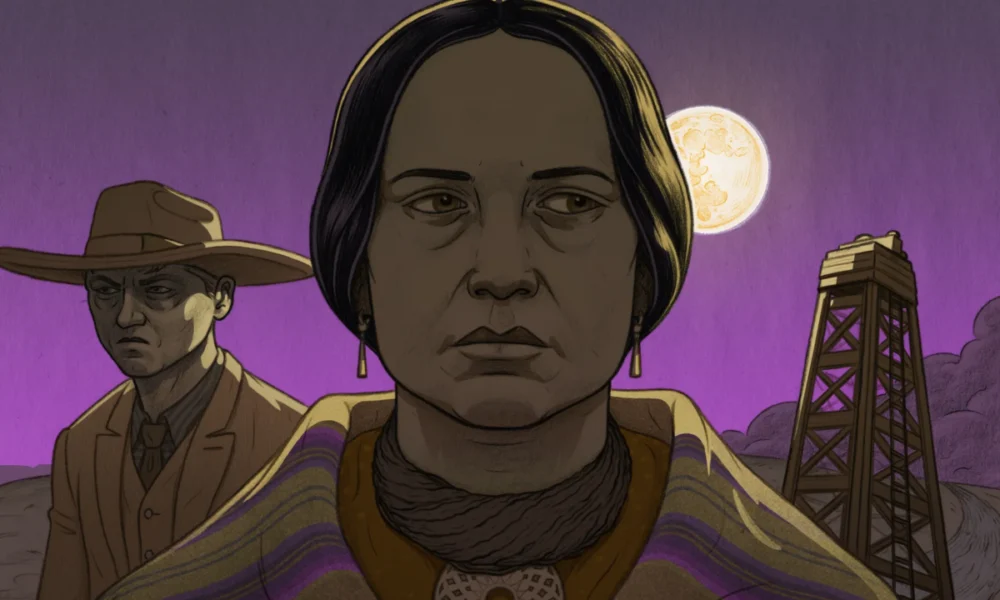Spoilers ahead for Killers of the Flower Moon
Martin Scorsese’s latest film, Killers of the Flower Moon was released in theatres this past weekend after premiering at the Cannes Film Festival to a nine-minute-long standing ovation. Known for directing iconic films such as Taxi Driver and The Wolf of Wall Street, Scorsese moves away from thrilling dramas to delve into the heart of a historical atrocity. Based on a true story, the film is adapted from David Grann’s non-fiction book Killers of the Flower Moon: The Osage Murders and the Birth of the FBI. The events took place in the 1920s, when the Osage Nation of Oklahoma became the richest people per capita after they discovered oil beneath their land. In the following years, the Osage people faced a slow massacre as white settlers began to murder countless members of their community for their oil money. The film shows the devastating consequences of greed and the dark, settler colonial underbelly of the American Dream in the early 20th century. Scorsese achieves this by meticulously portraying the intricate web of cover-ups and betrayal behind the murders and the unsettling nature of their duplicity.
The film centres around Ernest Burkhart (Leonardo DiCaprio), a man who moves to Oklahoma to work with his uncle William “King” Hale (Robert De Niro). Hale poses as an ally to the Osage community while scheming to take ownership of their oil money. Following King’s advice, Ernest pursues a romantic relationship with Osage member Mollie (Lily Gladstone). While obviously beneficial for Ernest, this relationship insidiously chips away at Mollie and the entire Osage community.
Dicaprio and De Niro are both excellent in their roles, but Lily Gladstone’s performance truly steals the show. Through her stellar conviction, she captures Mollie’s wide-ranging emotional journey. Mollie’s family disapproves of her union with a white man, while when she marries Ernest, he is dissatisfied with her steadfast commitment to her Osage heritage and her resistance to Western medicine. Mollie’s storyline is heartbreaking, as she is forced to endure her family’s gradual demise at the hands of her husband’s greed. The film is brutal and honest, refusing to ignore the gore and destruction of the tragedy. Sitting at close to three and a half hours, this adaptation provides the relevant background information, surrounding details, and insight into each character to provide a full account of the real tragedy.
Despite its acclaim, the film has faced criticism on multiple fronts. Many have raised concerns about the predominantly white cast and crew involvement in a movie centred on Indigenous suffering. Kanien’keha:ka actress Devery Jacobs expressed her concerns about the film surrounding the white saviour element and the excessive violence, which in her opinion, detracted from the core narrative. Kate Nelson, an Alaska Native Tlingit commentator affiliated with the BBC, conveyed a similar perspective. Nelson said that while Indigenous people can appreciate their stories being told, there is still a strong desire for them to be portrayed from their own perspective. Although Scorsese consulted Osage peoples in making the film, it is still yet another rendition of a white filmmaker telling Indigenous stories. Simultaneously, this adaptation is one of the most influential and widespread attempts to shed light on an Indigenous narrative.
Killers of the Flower Moon serves as a compelling revelation of a shockingly-overlooked chapter in history. However, the film also serves as a poignant reminder that these injustices persist; the crisis of missing and murdered Indigenous women, girls, and two-spirit people in North America underscores a disturbing, settler colonial pattern of disproportionate violence against Indigenous peoples. And, the police often overlook their disappearances. While Scorsese has consistently demonstrated a penchant for bringing true stories to the forefront, his latest film works to spotlight a marginalized community that endured an exceptionally devastating history. The movie uncovers a long-neglected historical atrocity but also stands as a stark reminder of the ongoing settler colonial violence that Indigenous peoples face, urging us to confront these enduring issues.









